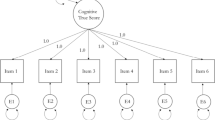Abstract
We propose a functional version of extended redundancy analysis that examines directional relationships among several sets of multivariate variables. As in extended redundancy analysis, the proposed method posits that a weighed composite of each set of exogenous variables influences a set of endogenous variables. It further considers endogenous and/or exogenous variables functional, varying over time, space, or other continua. Computationally, the method reduces to minimizing a penalized least-squares criterion through the adoption of a basis function expansion approach to approximating functions. We develop an alternating regularized least-squares algorithm to minimize this criterion. We apply the proposed method to real datasets to illustrate the empirical feasibility of the proposed method.







Similar content being viewed by others
References
Almansa, J., & Delicado, P. (2009). Analysing musical performance through functional data analysis: rhythmic structure in Schumann’s Traumerei. Connection Science, 21, 207–225.
Anderson, T.W. (1951). Estimating linear restrictions on regression coefficients for multivariate normal distributions. Annals of Mathematical Statistics, 22, 327–351.
Davies, P.T., & Tso, M.K.-S. (1982). Procedures for reduced-rank regression. Applied Statistics, 31, 244–255.
Efron, B. (1982). The jackknife, the bootstrap and other resampling plans. Philadelphia: SIAM.
Goldberger, A.L., Amaral, L.A.N., Glass, L., Hausdorff, J.M., Ivanov, P.C., Mark, R.G., Mietus, J.E., Moody, G.B., Peng, C.K., & Stanley, H.E. (2000). PhysioBank, PhysioToolkit, and PhysioNet: components of a new research resource for complex physiologic signals. Circulation, 101(23), e215–e220.
Hastie, T., Tibshirani, R., & Friedman, J. (2009). The elements of statistical learning: data mining, inference, and prediction (2nd ed.). New York: Springer.
Hoehn, M.M., & Yahr, M.D. (1967). Parkinsonism: onset, progression and mortality. Neurology, 17, 427–442.
Hoerl, A.E., & Kennard, R.W. (1970). Ridge regression: application to nonorthogonal problems. Technometrics, 12, 69–82.
Hwang, H. (2009). Regularized generalized structured component analysis. Psychometrika, 74, 517–530.
Izenman, A.J. (1975). Reduced-rank regression for the multivariate linear model. Journal of Multivariate Analysis, 5, 248–264.
Jackson, I., & Sirois, S. (2009). Infant cognition: going full factorial with pupil dilation. Developmental Science, 12, 670–679.
Lee, S., Bresch, E., & Narayanan, S. (2006). An exploratory study of emotional speech production using functional data analysis techniques. In Proceedings of the 7th international seminar on speech production. Ubatuba, Brazil: Center for Research on Speech, Acoustics, Language and Music.
Malfait, N., & Ramsay, J.O. (2003). The historical functional linear model. Canadian Journal of Statistics, 31, 115–128.
Mattar, A.A.G., & Ostry, D.J. (2010). Generalization of dynamics learning across changes in movement amplitude. Journal of Neurophysiology, 104, 426–438.
Olshen, R.A., Biden, E.N., Wyatt, M.P., & Sutherland, D.H. (1989). Gait analysis and the bootstrap. Annals of Statistics, 17, 1419–1440.
Ramsay, J.O., & Silverman, B.W. (2005). Functional data analysis (2nd ed.). New York: Springer.
Rao, C.R. (1964). The use and interpretation of principal component analysis in applied research. Sankhya. Series A, 26, 329–358.
Reiss, P.T., & Ogden, T.R. (2007). Functional principal component regression and functional partial least squares. Journal of the American Statistical Association, 102, 984–996.
Takane, Y., & Hwang, H. (2005). An extended redundancy analysis and its applications to two practical examples. Computational Statistics & Data Analysis, 49, 785–808.
Tian, T.S. (2010). Functional data analysis in brain imaging studies. Frontiers in Quantitative Psychology and Measurement, 1, 1–11.
van den Wollenberg, A.L. (1977). Redundancy analysis: an alternative for canonical analysis. Psychometrika, 42, 207–219.
Vines, B.W., Krumhansl, C.L., Wanderley, M.M., Dalca, I.M., & Levitin, D.J. (2005a). Dimensions of emotion in expressive musical performance. Annals of the New York Academy of Sciences, 1060, 462–466.
Vines, B.W., Krumhansl, C.L., Wanderley, M.M., & Levitin, D.J. (2006). Cross-modal interactions in the perception of musical performance. Cognition, 101, 80–113.
Vines, B.W., Nuzzo, R.L., & Levitin, D.J. (2005b). Quantifying and analyzing musical dynamics: differential calculus, physics and functional data techniques. Music Perception, 23, 137–152.
Wedel, M., & Kamakura, W.A. (1998). Market segmentation: conceptual and methodological foundations. Boston: Kluwer Academic.
Yogev, G., Giladi, N., Peretz, C., Springer, S., Simon, E.S., & Hausdorff, J.M. (2005). Dual tasking, gait rhythmicity, and Parkinson’s disease: which aspects of gait are attention demanding? European Journal of Neuroscience, 22, 1248–1256.
Author information
Authors and Affiliations
Corresponding author
Additional information
We thank the Associate Editor and three anonymous reviewers for their constructive comments on an earlier version of the paper, which greatly improved the quality of the paper. The work reported in the paper was supported by the National Research Foundation of Korea Grant (No. 2011-0027731) funded by the Korean government (MEST) to the third author, and by the Social Science and Humanities Research Council of Canada and Fonds de Recherche sur la Société et la Culture to the fifth author.
Rights and permissions
About this article
Cite this article
Hwang, H., Suk, H.W., Lee, JH. et al. Functional Extended Redundancy Analysis. Psychometrika 77, 524–542 (2012). https://doi.org/10.1007/s11336-012-9268-2
Received:
Revised:
Published:
Issue Date:
DOI: https://doi.org/10.1007/s11336-012-9268-2




